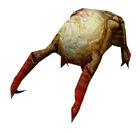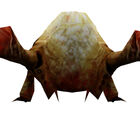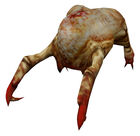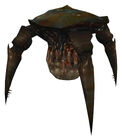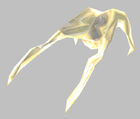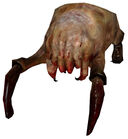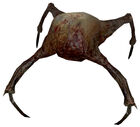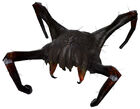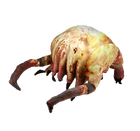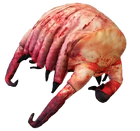No edit summary Tags: Visual edit apiedit |
(Irrelevant. I wouldn't even put it in Trivia.) Tag: sourceedit |
||
| (One intermediate revision by one other user not shown) | |||
Revision as of 11:41, 30 March 2015
| To illustrate the article add one or more relevant images or upload them from canonical / official sources. For more instructions visit Half-Life Wiki:Images. |
- "Have you ever seen such a magnificent species? These 'crabs' can completely control their host's nervous system. Can you imagine what the next stage of mutation looks like?"
- ―Black Mesa scientist[src]
Headcrabs, derisively called "headhumpers" by Barney Calhoun and known as "parasitics" and "biotics" by the Combine Overwatch, are omnivorous, parasitic creatures. They are widely considered one of the most iconic aliens of the Half-Life series.
Overview

The Standard Headcrab's underbelly.
Headcrabs are small creatures, roughly the size of a pumpkin. They are covered in smooth skin, which varies in color between subspecies, and crawl on four short legs. These legs provide enough jumping power to leap up to 3 meters (10 feet) in any direction.
Their underbelly is almost completely covered by a large, lipless mouth, with a hidden "beak" used for feeding and for latching onto the skulls of victims (see below). As seen on Xen in Half-Life, Headcrabs appear to typically be born out of Gonarchs; therefore, some Headcrabs may evolve into Gonarchs, and never use a host.
The Headcrab's, or at least the Standard Headcrab's, natural predator appears to be the Bullsquid. A couple of scenes in Half-Life feature Bullsquids using their ranged attack to kill Headcrabs, who in turn attempt to defend themselves but are killed first. The Bullsquid then comes crawling over to feed on them. Although this behavior is not seen on Xen in the creatures' naturals habitats, it can still be safely assumed that Bullsquids naturally prey on Headcrabs.
Headcrabs were studied at Black Mesa, notably in the Advanced Biological Research Lab and the Gamma Labs.
During the Combine occupation of Earth, Headcrabs appear to have no external sensory organs, including eyes or ears, while the Standard Headcrab had 3 eyes on each side of its body 20 years prior. The Standard Headcrab can also be seen burrowing in and out of the ground, but not the other species.
The Headcrab comes in several subspecies:
- The Standard Headcrab - the first Headcrab introduced in Half-Life, seen in its infant form near the end of the game. It turns its host into a Standard Zombie, and in some cases a Gonome.
- The Gonarch - a much larger, mature Headcrab species which spawns baby Headcrabs. Does not use hosts.
- The Fast Headcrab - introduced in Half-Life 2, and much faster than Standard Headcrabs. Turns its host into a Fast Zombie.
- The Poison Headcrab - a toxic Headcrab, causing more damage to the host. Also introduced in Half-Life 2, it turns its host into a Poison Zombie.

Headcrabs can be domesticated, as seen with Lamarr, Isaac Kleiner's pet Headcrab. Lamarr has been "de-beaked", and is said to be completely harmless; removing the beak of Headcrabs renders them unable to cut into a host head, making them harmless and apparently less aggressive. This implies that the beak of a Headcrab makes them irritable and prone to aggression due to pain and/or discomfort, in a manner similar to a human's wisdom teeth.
It appears that the flesh of both Standard and Fast Headcrabs is edible, at least by Vortigaunts. The former can be seen being prepared by Vortigaunts in Black Mesa East while the latter can be seen being roasted by the All-Knowing Vortigaunt. The poison headcrabs, however, are not edible; if a barnacle eats a poison headcrab, it dies after swallowing the headcrab.
Zombification
Headcrabs are a parasitic species. Upon sighting a humanoid host, a headcrab will leap for the victim's face and affix itself to the cranium, whereupon they will use their beak to break into the victim's skull. The Headcrab then proceeds to take over its host's motor functions through some unknown biological process. The host will then undergo physical changes, presumably induced through chemical means; although the mutations vary between headcrab subspecies, common changes include the elongation of hands and fingers, reduction or removal of skin and muscle tissue across much of the body, and the exposure of the organs inside the chest cavity. Headcrabs keep their host alive throughout the entire process, helpless and unable to remove the headcrab or resist its control. As seen in Station 6 in Half-Life 2, it apparently takes anywhere from several seconds to several minutes for a Headcrab to turn humans into Zombies.
The host appears to retain partial consciousness once the Headcrab has taken control. Standard Zombies retain a certain ability to talk, always heard as violent cries for help. "Zombines" seem to be able to speak with their vocoders (this is disputed, however). Each Headcrab subspecies affects its host in its own unique way, producing a Zombie extremely distinct from the other types, in both appearance and behavior.
Despite their non-Earth origin, headcrabs appear to be uniquely well-suited for parasitizing human hosts: their mouths fit perfectly over a human cranium, and their internal chemistry is compatible with that of humans such that the headcrabs can alter their bodily makeup. It is possible that they were specifically engineered by the inhabitants of Xen as a form of biological warfare, to be used against humanity during the invasion of Earth. It is also possible that they are naturally-occurring creatures, and that they have evolved to parasitize any humanoid host regardless of origin; this would imply that they are capable of parasitizing Vortigaunts, Alien Grunts, and other humanoid Xen residents, although no examples of zombies from any of these species are known to exist.
Combine application
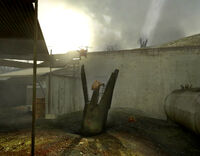
Standard Headcrabs emerging from a deployed Headcrab Shell.
In Half-Life 2, the Combine are seen utilizing Headcrabs as a form of biological weaponry against the Resistance. "Headcrab Shells," as they are known, are large mortar shells containing a payload of Headcrabs, which are released on impact, free to infect or terrorize anyone nearby. If used in large numbers, these shells are highly effective in neutralizing a large Resistance base. The effects of large-scale Headcrab shelling are seen during Gordon's visit to the devastated town of Ravenholm, where most inhabitants have been turned into Zombies.
In Episode One, it seems that the Combine have begun to lose control over their bio-weapon; Headcrabs begin infecting Overwatch Soldiers, showing that the large-scale effects of shelling have caused even Combine-controlled areas to be affected.
Behind the scenes
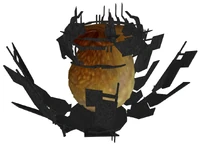
The Combine Big Momma Pod.
- Originally, a device holding a Gonarch's sack, nicknamed the "Combine Big Momma Pod" (a reference to the Gonarch's nickname), was to be used by the Combine for obtaining large numbers of Headcrabs for use in Headcrab Shells,[2] and to be encountered in the Ravenholm mine.[3] Since the device does not appear in the final games, it is unknown so far how the Combine breed their Headcrabs.
- While the Headcrabs found in Half-Life and its expansions are able to swim and survive in water but not in areas contaminated by toxic waste and radioactivity, this is reversed in Half-Life 2 and its Episodes, where Headcrabs can be found surviving in toxic areas, and drowning when entering water. The Headcrab's new resilience towards toxic and radioactive materials even appears to be passed on to the hosts they infest, as Zombies are frequently found in conditions that would otherwise be hazardous to their hosts. This may be the result of their adaption to Earth's features, or modifications applied to them by the Combine.
- The Headcrabs in Half-Life 2 cannot attack the player if he is inside a vehicle. They will only rush at the vehicle and attempt to push it, but they end up being crushed by the vehicle instead. However, this can be advantageous to Poison Headcrabs since their attack can be very dangerous.
Gallery
Half-Life and its expansions
Half-Life 2 and its Episodes
Official merchandise
List of appearances
- Half-Life: Day One (First appearance)
- Half-Life
- Half-Life: Uplink (Non-canonical appearance)
- Half-Life: Opposing Force
- Half-Life: Blue Shift
- Half-Life: Decay
- Half-Life 2
- Half-Life 2: Raising the Bar
- Half-Life 2: Episode One
- Half-Life 2: Episode Two
External links
References
- ↑ Half-Life 2: Raising the Bar
- ↑ Playable Half-Life 2 Beta files
- ↑ Playable Half-Life 2 Beta
| Creatures | Alien Aircraft • Alien Controller • Alien Grunt • Archer (cut) • Armored Headcrab • Barnacle • Boid • Bullsquid • Charger (cut) • Chumtoad • Fast Headcrab • Fast Walker (cut) • Flocking Floater (cut) • Gargantua• Gonarch • Headcrab • Houndeye • Ichthyosaur • Kingpin (cut) • Leech • Lightning Dog • Mr. Friendly (cut) • Nihilanth • Panther Eye (cut) • Poison Headcrab • Protozoan • Prrobot (cut) • Quiver Creature (cut) • Sand Barnacle (cut) • Snapbug (cut) • Snark • Sphere (cut) • Standard Headcrab • Stukabat (cut) • Tentacle • Unidentified Quiver Creature (cut) • Vortigaunt • Zombie |
|---|---|
| Weapons | Black Hole Gun (cut) • Ceiling Turret • Grenade • Hivehand • Sentry Cannon • Snark • Snark Mine |
| Technology | Healing Shower • Thumper |
| Other | Crystal • Fungus • Healing Pool • Light Stalk • Trampoline • Tree |

